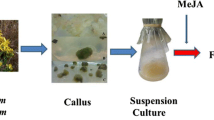Abstract
The optimum growth stage for enhancing ajmalicine production in Catharanthus roseuscultures with methyl jasmonate (MJ) was after 6 d growth. MJ added at 10 or 100 μm on day 6 gave a maximum ajmalicine production of 10.2 mg l−1, a 300% increase over that of non-elicited cultures.
Similar content being viewed by others
References
Aerts RJ, Gisi D, De Carolis E, De Luca V, Baumann TW (1994) Methyl jasmonate vapor increases the developmentally con-trolled synthesis of alkaloids in Catharanthus and Cinchona seedlings. Plant J. 5: 635–43.
Asada M, Shuler ML (1989) Stimulation of ajmalicine production and excretion from Catharanthus roseus: effects of adsorption in situ, elicitors, and alginate immobilization. Appl. Microbiol. Biotechnol. 30: 475–481.
Collu G, Unver N, Peltenburg-Looman AMG, van der Heijden R, Verpoorte R, Memelink J (2001) Geraniol 10-hydroxylase, a cytochrome P450 enzyme involved in terpenoid indole alkaloid biosynthesis. FEBS Lett. 508: 215–220.
Contin A, van der Heijden R, ten Hoopen HJG, Verpoorte R (1998) The inoculum size triggers tryptamine or secologanin biosyn-thesis in a Catharanthus roseus cell culture. Plant Sci. 139: 205–211.
Gantet P, Imbault N, Thiersault M, Doireau P (1998) Necessity of a functional octadecanoic pathway for indole alkaloid synthesis by Catharanthus roseus cell suspensions cultured in an auxin-starved medium. Plant Cell Physiol. 39: 220–225.
Gundlach H, Muller MJ, Kutchan TM, Zenk MH (1992) Jasmonic acid is a signal transducer in elicitor-induced plant cell cultures. Proc. Natl. Acad. Sci. USA 89: 2389–2393.
Ketchum REB, Gibson DM, Croteau RB, Shuler ML (1999) The kinetics of taxoid accumulation in cell suspension cultures of Taxus following elicitation with methyl jasmonate. Biotechnol. Bioeng. 62: 97–105.
Lee-Parsons CWT, Shuler ML (2002) The effect of ajmalicine spiking and resin addition timing on the production of indole alkaloids from Catharanthus roseus cell cultures. Biotechnol. Bioeng. 79: 408–415.
Mizukami H, Tabira Y, Ellis BE (1993) Methyl jasmonate-induced rosmarinic acid biosynthesis in Lithospermum erythrorhizon cell suspension cultures. Plant Cell Rep. 12: 706–709.
Qian Z-G, Zhao Z-J, Xu Y, Qian X, Zhong J-J (2004) Novel chemically synthesized hydroxyl-containing jasmonates as powerful inducing signals for plant secondary metabolism. Biotechnol. Bioeng. 86: 809–816.
Rijhwani, SK, Shanks JV (1998) Effect of elicitor dosage and exposure time on biosynthesis of indole alkaloids by Catharanthus roseus hairy root cultures. Biotechnol. Progr. 14: 442–449.
van der Fits L, Memelink J (2000) ORCA3, a jasmonate-responsive transcriptional regulator of plant primary and secondary metabolism. Science 289: 295–297.
Author information
Authors and Affiliations
Rights and permissions
About this article
Cite this article
Lee-Parsons, C.W., Ertürk, S. & Tengtrakool, J. Enhancement of ajmalicine production in Catharanthus roseuscell cultures with methyl jasmonate is dependent on timing and dosage of elicitation. Biotechnology Letters 26, 1595–1599 (2004). https://doi.org/10.1023/B:BILE.0000045825.37395.94
Issue Date:
DOI: https://doi.org/10.1023/B:BILE.0000045825.37395.94




